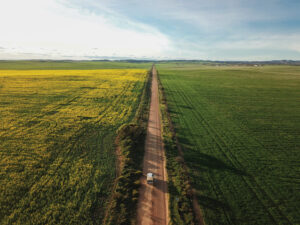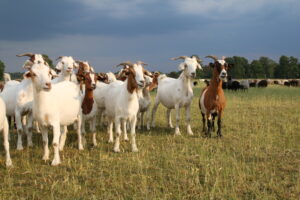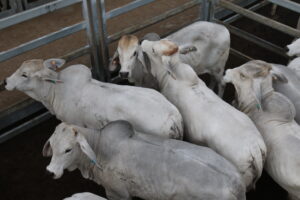Goat meat prices have fallen since mid-2022, in sympathy with sheep meat price trends. In March we were looking at the upper bound for goat meat prices. In this article we go to the other extreme and look for a lower bound on goat meat prices.
In March Mecardo showed how the annual goat meat price could match the NSW trade lamb saleyard price but not higher. The assumption concluded was that the trade lamb price per kg was the upper limit or bound for goat meat prices. Figure 1 is an update of a schematic shown in March, with the annual seasonal average price ratio for goat meat to trade lamb from 2003-2004 onwards. The price ratio for the season to date (July to December) is still running at close to one.
As Figure 2 shows goat meat prices have suffered a big decline of over 50% since mid-2022, as the Mecardo article in September noted. The goat to lamb price ratio has dropped to close to 0.5 so the lamb price is not holding goat meat prices back. In Figure 2 the goat meat price ratio to mutton (a NSW saleyard price series) is shown in order to look at a possible lower bound for the goat meat price.
The goat to mutton price ratio has varied widely since 2003, with some extreme levels in late 2006 when mutton went through what has been the classic drought sell off where mutton prices are driven into the ground by farmers offloading older sheep. This pattern has not applied in droughts since then. During the past decade the ratio has ranged from around 0.8 to 1.8, and is now close to 1.0. It is tempting to think that the mutton price is the lower bound for goat meat prices, with goat meat prices ranging between mutton on the low side and lamb on the high side.
To give a feel what this would mean in practical terms Figure 3 shows the mutton to lamb price ratio (both NSW saleyard series) from 2003 onwards, with the calendar year average overlaid. This is quite a deal of variation within season as the month variation about the annual average shows. Since 2014 the low point for the ratio in monthly terms has been around 0.54 (where it is now) with the season average holding in the 0.6-0.65 range. On the high side mutton has reached 0.85 of the lamb price in monthly data and 0.78 in annual average data. On a monthly timeframe if mutton is the lower bound for goat meat then the current price ratio of 1.0 means the goat price will steady if mutton steadies – where goes mutton in the short term goat follows.
What does it mean?
Time will tell if the lower price level for goat meat is mutton, but at this stage a range of 0.8 to 1.0 times the mutton price looks to be a plausible base level for goat meat. On the high side, trade lamb prices are the upper limit on price. In terms of budgeting this provides a rule of thumb where information from larger and more transparent related markets (lamb and mutton) can be used for goat enterprises.
Have any questions or comments?
Key Points
- The mutton price could be used as an indicator for the lowest level that goat meat prices may get to.
- The most significant departure from this rule of thumb is where the goat price breached 80% of the mutton price briefly in 2013 and 2014.
- Theoretically, the goat price will generally operate somewhere between the mutton and trade lamb price, and this can be applied in practice when budgeting.
Click on figure to expand
Click on figure to expand
Data sources: MLA, ICS















